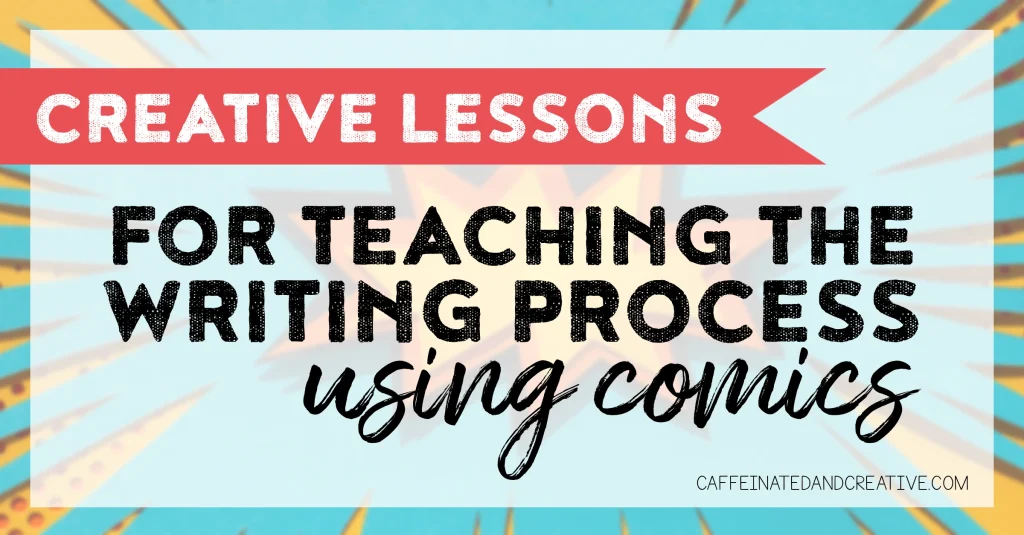
Picture this. Everything has gone great so far in your day of teaching. There were no early meetings that could have been an e-mail. A parent donated Clorox Wipes(which is equatable to gold) and your students are finally mastering two-digit multiplication. Everything is going all lovely until you look at your lesson plan and see it there practically shouting at you. “Writing time.”
Teaching writing is sometimes a dreaded concept to teach. I personally think that the reason every teacher has a favorite subject is that they liked it themselves as a kid. I was never good at math and instead loved spending my time writing. One of my favorite memorable lessons I did as a kid was creating a comic!
Writing: A Throwback
Even before I properly learned how to write, I was writing. My best friend and I would write stories scrawled out poorly with drawings that were laughable(and haven’t gotten much better). My cousins and I would write up newspapers about what was going on in the world. Then after moving twice in the span of a few years, writing letters to all of my friends was a given.

Thinking back on all my time writing I was wondering what led me to want to write more. I chalk it up to my teachers who made writing fun. I remember one project was to make a magazine complete with a comic. This was kind of like our own take on Highlights Magazines. I loved reading comics in the Sunday paper and in the Highlights Magazine. Props if you remember the best comic strip, The Timbertoes.
As a teacher I wanted kids to be able to learn how to write in a way that could make it fun and one way was to have them make their own comic book! This was a fun way for kids to get into writing because I think anytime you can involve drawing and/or superheroes, you can engage most kids.
Ideas for Using and Creating Comics in the Classroom
There are many chapter books that are now graphic novels. To use comics and graphic novels in the classroom here are just SOME ideas!
- Make photocopies of pages of popular graphic novels or comics. Then white out any speech bubbles. Make a new copy for students to fill out the text.
- Have students work in groups to learn about sequencing. One person will start the panel and then pass it to the next person.
- In pairs, students can delegate who will draw and who will write. Working on different tasks will require them to use lots of details so their partner knows what to draw or write.
- Don’t just stop at writing! Comics are a great way to teach grammar! Adjectives and onomatopoeia are especially fun to teach with comics!
- Using a picture or chapter book, have students create a comic for it. For a more integrated lesson, have them create a comic page for each chapter to show their understanding of the novel.
Comic Book Writing
If you are psyched to introduce a fun way to teach creative writing, but at a loss at how to fit in different factors of writing, my best-selling Comic Book Writing Lesson has everything you need to teach students about characterization, plot, setting, dialogue, brainstorming, and much more!
I recommend starting off with reviewing the very basics. Grammar, punctuation, and all that other necessary stuff. THEN comes the fun part. To make a comic it realllly helps to know the comic vocab. Did you know that there are comic panels, strips, and books?! I had no idea until I started making this unit!
After learning about the components of a comic, we take it a step further and learn about what makes a comic a bit different than other forms of writing. Adjectives, dialogue, using quotation marks, sequencing, setting, character traits and more are just some topics covered in this unit!
Let’s not forget the ever important onomatopoeia…AKA, sounds! Your class will learn about sounds (much easier to say even as an adult) and even get to practice drawing/writing sounds, plus speech and thought bubbles!
Next it’s time to put on their thinking caps! Students will brainstorm the key components of their comic such as characters, setting, problem, and solution.
This is where you will begin to see your student’s creativity soar! When breaking apart each aspect of a comic (characters, setting, plot, problem, solution) it’s easier for students to grasp each component rather than trying to teach all of it at once! I recommend having them plan out their characters first so they then can use actual names when plotting out everything else.
Your class will then work on drafting things out. This resource was made so you can tailor it to fit your students skills. All of the planning pages include different options for either writing (different sized handwriting lines) or even drawing!
FINALLY, they get to create a comic! My unit contains a crazy amount of different templates so they can create comic strips, panels, or even full comic books! Included are hands-on elements such as narration boxes and speech bubbles they can add to their comics! There are even digital options(and TUTORIALS) for those tech-savvy students!
For the unit, I used a superhero theme, but comics can be about anything! Encourage your students to get creative and share comics that are about things other than superheroes. For example, Garfield, Calvin and Hobbes, Family Circle, Archie, Richie Rich, etc. (My age is showing here). No matter what topic they choose to write about, your students are guaranteed to have fun writing! Grab my Comic Book Writing Lesson today by clicking the link or the image below!










